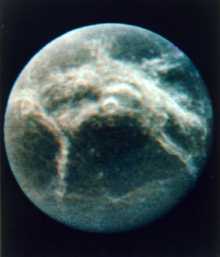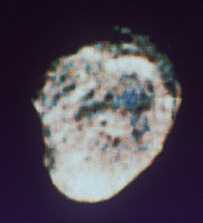This is an image of Rhea.
Click on image for full size
NASA/JPL
The Surface of Rhea
The surface of Rhea is typical of an icy moon. Rhea is as heavily cratered as
Mimas on its leading hemisphere.
Rhea's trailing hemisphere is dominated by unusual white streaks extending for many kilometers over its surface. These streaks indicate that some geologically active processes on Rhea have been involved in resurfacing it. These active processes may include deposits of snow from fractures in the crust.
You might also be interested in:

The surface of Dione does not have many craters, which is an indication of changes to the surface in the past. Instead it has wispy white streaks similar to those found on Rhea extending for many kilometers
...more
Rhea was discovered by G. Cassini in 1672. Rhea is the 5th farthest moon from Saturn, with a standoff distance of 527,040 km. It is one of the icy moons, similar to the Galilean satellites. Rhea is about
...more
This is an image of the Earth's moon, shown in the lower left, with the six much smaller icy moons of Saturn. The moons in order, starting from the top left are: Mimas, Enceladus, Tethys, Dione, Rhea,
...more
Dione was discovered by G. Cassini in 1684. Dione is the 7th farthest moon from Saturn, with a standoff distance of 377,400 km. It is a small icy moon, lightly cratered, with wispy white streaks across
...more
The surface of Enceladus does not have many craters. Instead it has grooves similar to those found on Ganymede. These grooves extend for many kilometers over the surface. The presence of grooves indicates
...more
Helene was discovered on February 29, 1980, by Pierre Laques and Raymond Despiau of the Pic du Midi Observatory, France, and J. Lecacheux from the Meudon Observatory, France. Their discovery was made using
...more
Hyperion was discovered by W. Bond in 1848. Hyperion is the 3rd farthest moon from Saturn, with a standoff distance of 1,481,000 km. Hyperion is 175 x 100 km (117 x 67 miles) in size. Its dimensions make
...more
The surface of Rhea is typical of an icy moon. Rhea is as heavily cratered as Mimas on its leading hemisphere. Rhea's trailing hemisphere is dominated by unusual white streaks extending for many kilometers
...more












